Churches, Romania
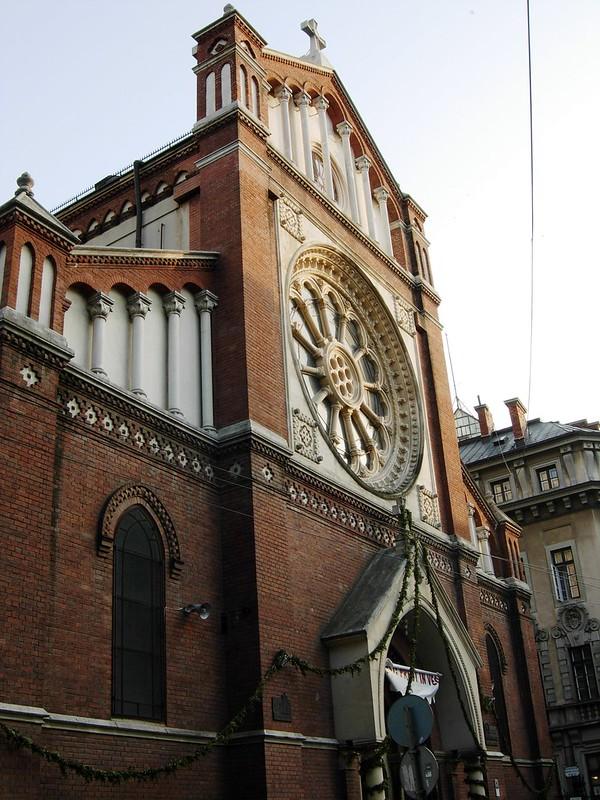
Removed from Unnamed collection
Saint Joseph Cathedral 
The Cathedral of Saint Joseph is the most important Roman Catholic Church in Bucharest serving, at the same time, as cathedral of the Roman Catholic Archbishopric in Bucharest and Metropolitan Cathedral of the Roman Catholic Church in Romania. The crucial role of this place of worship in the religious life of the community of Roman Catholic believers in Bucharest and nationwide alike is, thus, understandable.
Built between 1873 and 1884 (the construction works took so long because of the War of Independence in 1877), the cathedral is an architectural monument erected by following the design of Friedrich Schmidt, combining elements typical of the Roman style with discreet Gothic touches. The inner highlights of the cathedral refer to the main white Carrara marble altar (built in Rome by following the designs of the same Friedrich Schmidt), to an impressive organ (the present organ was built in 1930 in order to replace the original 1892 Parisian organ) said to be one of the best in the country, to the Parisian chandelier, to the decorative pictorial works by Georg Roder and Fr. Elsner, as well as to the decorative plasterwork on the walls, columns and pillars. http://www.tourism-bucharest.com/bucharest-attractions/places-of-worship-in-bucharest/cathedral-of-saint-joseph.html
Map
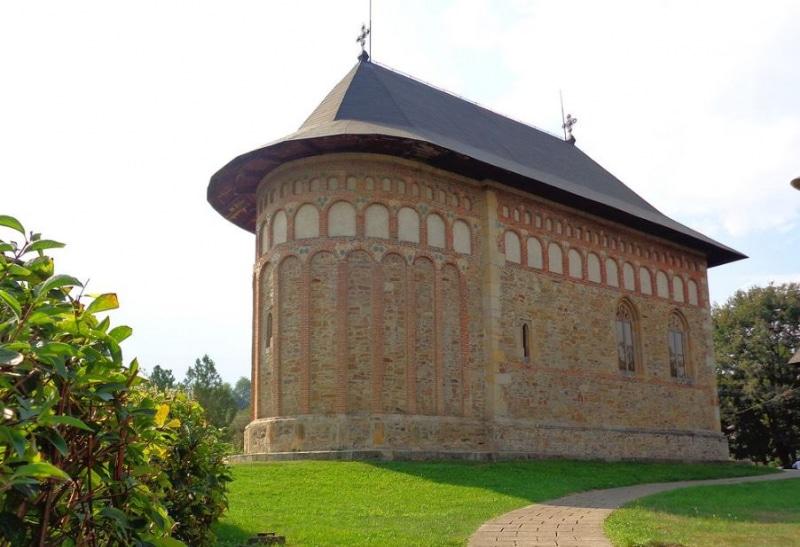
Removed from Unnamed collection
Borzesti Church 
Borzesti is the village (currently, is a neighbourhood of the city Onesti) from Bacau, where Stephen the Great was born and raised.
He founded together with his eldest son Alexandru (1464-1496), the church "Assumption". It was built between July 9, 1493, of October 12, 1494.
Legend says that the church was dedicated to a child killed during the invasions of the Tatars.
The church is designed in a Moldavian style, just like the Razboieni Church and the Piatra Neamt Church (1497–1498). http://www.uvisitromania.com/tourist-attractions/bacau/borzesti-church-id575
Map

Removed from Unnamed collection
Precista Church 
Precista church is one of the most famous churches of Bacau. Having patron Assumption, the church is part of the architectural complex of the Princely Court of Bacau. http://www.uvisitromania.com/tourist-attractions/bacau/precista-church-id574
Map

Removed from Unnamed collection
Orthodox Metropolitan Cathedral 
The Orthodox Metropolitan Cathedral (Avram Iancu Square) – Romanian Orthodox Mitropoly of Cluj, Alba, Crisana, Maramures. Archiepiscopate of Vad, Feleac and Cluj (18 Avram Iancu Square). It was built between 1923-1933, according to the plans of the architects Constantin Pompoiu and George Cristinel, representing the Romanian stylistic current. It is one of the most important religious buildings from Cluj Napoca municipality.
The church is dedicated to the Assumption – the date in which the Romanian Army entered Transylvania (15th of August 1916).
In 1973, when the Diocesan See of Cluj was made Archiepiscopate, the church became an archepiscopal cathedral. Since 1996, the cathedral had been in a great process of outside restoration, a process which came to an end in 1999. Inside, a new Byzantine painting was made, in the famous mosaic of Murano. Since 2006, the building has served as the cathedral of the Archiepiscopate of Vad, Feleac and Cluj, which is also metropolitan of Cluj, Alba, Crisana and Maramures. http://www.visitclujnapoca.ro/en/atractii-turistice/best-of-cluj-napoca/the-orthodox-metropolitan-cathedral.html
Map

Removed from Unnamed collection
Romano-Catholic Church Saint Michael 
The Roman Catholic "Saint Michael" Church (Unirii Square), a great historical and religious architecture monument are one of the most imposing gothic edifices from our country. It was built approximately between 1350 and 1480, being the first hall church from Transylvania.
The main portal, carved in 1444 in gothic style, ends with a high accolade, showing in the central part the carved image of archangel Michael. The tower from the north facade was built between 1834 and 1863 in neo-gothic style and it is 80 meter high, including the cross.
The inside and outside decorations and the baroque carved pulpit are also remarkable. An extraordinary execution is the portal of the sacristy, from the Renaissance (1528) with Italian motifs and a strong south-German influence. The body of the pulpit, in baroque style, was carved by Johannes Nachtigall and Anton Schuhbauer. The mural picture, fragmentary kept, shows stylistic influences from northern Italy and reveals the first signs of the Renaissance in the painting from Cluj-Napoca. http://www.visitclujnapoca.ro/en/atractii-turistice/best-of-cluj-napoca/page/2/the-roman-catholic-saint-michael-church.html
Map
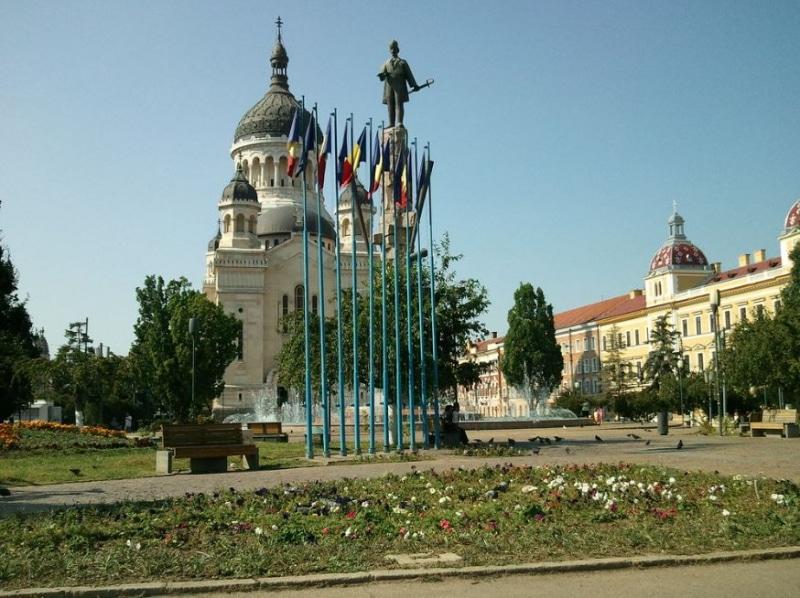
Removed from Unnamed collection
Avram Iancu Square 
On the western part of the old city walls, guarded by three bastions and gates, this square was initially a marketplace, which was going to be moved to the central square. Eventually, the marketplace was moved closer to the railroad, in the current location of Mihai Viteazul square. Thus, at the end of the 19th century and the beginning of the 20th century the walls and gates of the city were demolished, and a small park was arranged in this square.
Later, new buildings were erected here, such as the National Theater, the Orthodox Cathedral, the building of the Chamber of Commerce and Industry, in the Art Nouveau style (today, the office of the Cluj Prefecture); the building of the old “Unió” Masonic Lodge (no. 7 Avram Iancu Sq.); the building of the old military garrison (today, the building of the County School Inspectorate, also known in the oral tradition of the city as the “red building”, a name earned by the red brick walls of the building); the Palace of Justice, where the Court of Appeal and the Tribunal are housed; the EMKE Palace (Hungarian Cultural Association of Transylvania), later purchased by MÁV (Magyar Államvasútak, Hungarian State Railroads), currently the headquarters of the CFR Regional Office; the building of the Archbishopric of Vad, Feleac and Cluj, which houses the Faculty of Orthodox Theology and the building of the Protestant Theology, on the old site of the Reformed Church’s Prayer House. http://www.visitclujnapoca.ro/en/atractii-turistice/monumente-si-complexe-arhitectonice/avram-iancu-square.html
Map

Removed from Unnamed collection
The Church of Cosuna Monastery 
The Cosuna – Bucovatu Vechi Monastery is an orthodox monastery situated in Craiova, Dolj county. It is the oldest religious edifice from the city of Craiova, being built in 1483. The Monastery`s church was built between 1506 – 1512 and the actual church in 1572, by the Boyar Stephan and his son. http://www.informatii-romania.ro/en/listing/manastirea-cosuna/
Map

Removed from Unnamed collection
The Holy Trinity Orthodox Church 
This is one of many places of worship that were declared historical monuments and it can be visited on 5 Parcul Traian Street. Its troubled history had an influence on whom to choose as a patron saint and how its interior developed, since it was used consecutively by priests and believers of three denominations – Roman-Catholic, Ruthenian (Greek-Catholic) and, at present, Orthodox Christians. http://oradea.travel/en/?p=1957
Map
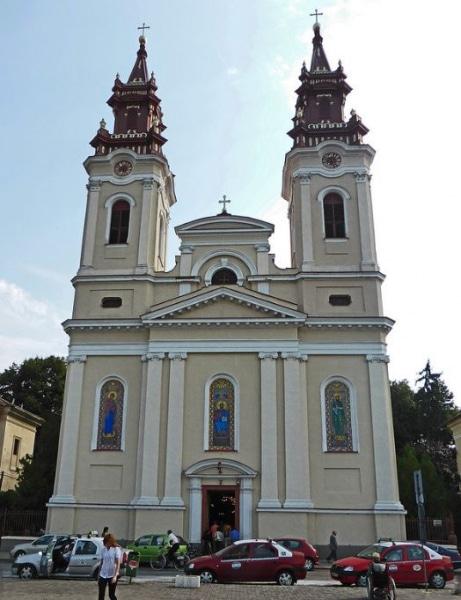
Removed from Unnamed collection
Cathedral Birth of St. John the Baptist 
The Cathedral "Birth of St. John the Baptist" is a monument of baroque architecture in the Arad city. The building was built between 1862-1865. The main funders of construction were family Mocioni and banker Gheorghe Sina.
The two towers of the facade were raised in 1904. The two towers are provided with a clock on each side.
The church served as the cathedral of the Diocese Arad until 2009, when Holy Trinity Cathedral in Arad, built since 1991, has acquired this feature. http://www.uvisitromania.com/tourist-attractions/arad/cathedral-birth-of-st-john-the-baptist-id540
Map
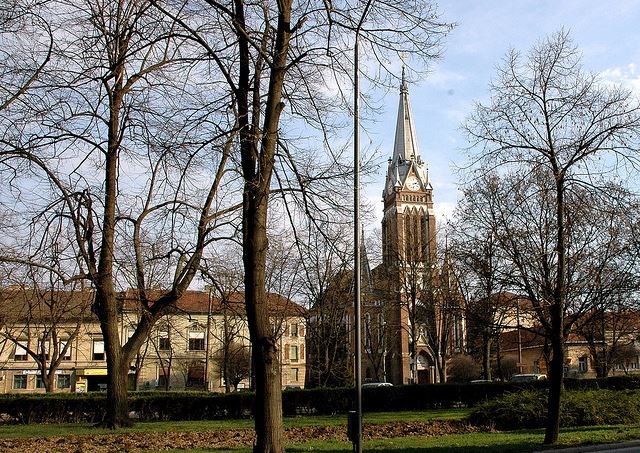
Removed from Unnamed collection
The Red Church 
The Red Church is a historical and architectural monument of the Arad city. The building serves as a place of worship of the Evangelical-Lutheran Church in Romania.
The name comes from the external finish of polished brick.
The church is built in 1906 in Gothic style, with the main tower of 46 meters and a Gothic-style stained glass.
At the inauguration, the church had three bells in weight 1590 kg. During World War I, from the disposal of the authorities have been melted two bells, from their bronze were made projectiles. The bells were cast in the foundry workshop Hönig from Arad, famous for bronze casting work. http://www.uvisitromania.com/tourist-attractions/arad/the-red-church-id537
Map
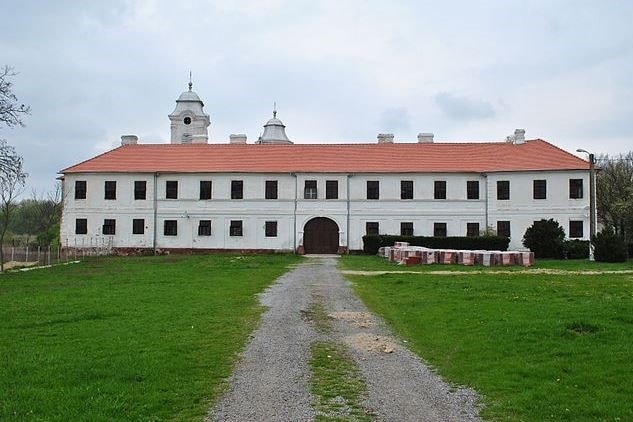
Removed from Unnamed collection
Bezdin Monastery 
The Bezdin Monastery is a monastery dedicated to the Assumption, located in Lunca Muresului Natural Park, near the village Munar, Arad County, on the right bank of the river Mures.
The monastery was founded in 1539, the name comes from the Bezdin lake located in the eastern part of the monastery.
During the Ottoman occupation, the monastery was burned by the ottomans, and in 1690 a brick church was built in Byzantine style as a form of clover with three abisade.
Inside the church is a miraculous icon of Our Lady, brought from Mount Athos. http://www.uvisitromania.com/tourist-attractions/arad/bezdin-monastery-id549
Map

Removed from Unnamed collection
Basilica Maria Radna 
In 1642 Pater Andrija Stipancic, an observant franciscan monk from the “Bosna Argentina” province and priest at Radna, succeeds, after a long pilgrimage on foot made to Istambul and back, to obtain an Embre from the sultan for the renovation of his chapel. http://www.uvisitromania.com/tourist-attractions/arad/basilica-maria-radna-id532
Map
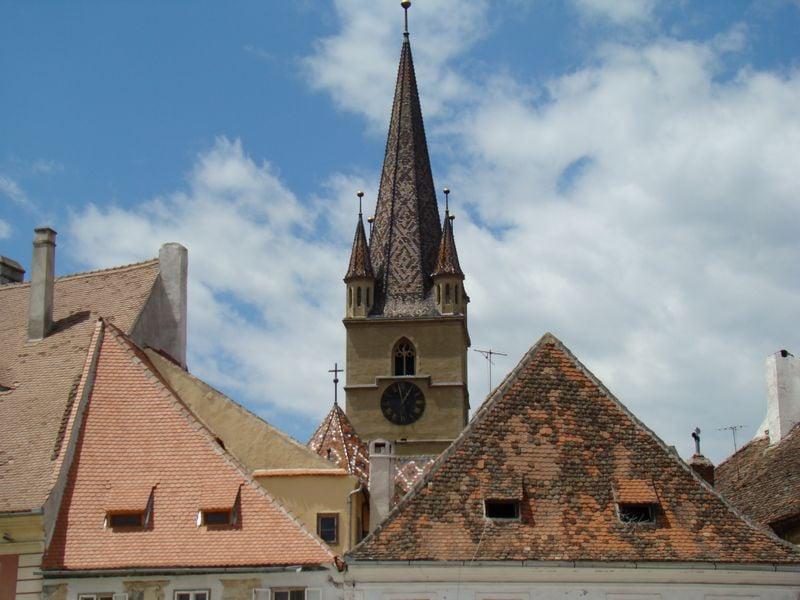
Removed from Unnamed collection
The Evangelic Church 
The Evangelic Church is one of the most impressive buildings in Sibiu. It was raised in the 14th century on the location of an old Roman church dating from the 12th century. The building is dominated by the seven level tower with the four towers on the corners, a mark showing that the city had the right of condemnation. With a height of 73.34 meters, the tower is the tallest in Transylvania. http://www.turism.sibiu.ro/index.php/en/biserica/152
Map

Removed from Unnamed collection
Assumption of Mary Cathedral 
The Assumption Cathedral in Baia Mare is a place of worship built by the Greek Catholic faithful in Baia Mare between 1905-1911.
The building is declared a historical monument (code LMI MM-II-mB-04471), next to the episcopal palace of the Greek Catholic Episcopate of Maramureș and the former confessional school (currently Șc. Gen. no. 2), all located on Vasile Lucaciu Street from the municipality of Baia Mare. https://www.baiamare.ro/ro/Descopera-Baia-Mare/Obiective-turistice-si-atractii/Atractii-turistice/Catedrala-Adormirea-Maicii-Domnului/
Map
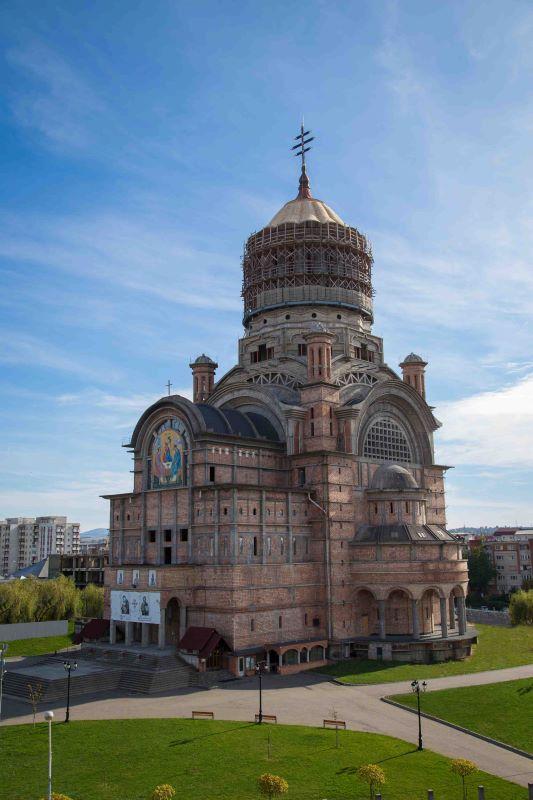
Removed from Unnamed collection
Holy Trinity Cathedral 
The Holy Trinity - the roman-catholic cathedral was built in 1766 by Jesuits on the place of former St. Martin church. The cathedral holds an organ with three registers, built between 1940-1944.
The cathedral, which is the perspective head of the Unirii Boulevard in Baia Mare, is an impressive building, representative for the construction of churches in Transylvania, built in the tradition of Orthodox churches, with dimensions of 85 m long, 50 m wide and 85 m high. The cathedral capacity is about 3000 people. From the first level, being plated with brick from Oradea, paved on the floor with porcelain stoneware from Spain and iconostasis made of brick with icons in Murano mosaic. Spacious altar, sf. brick table with a marble plate 2 / 1,50m, gr. 5cm., Oak furniture, wrought iron chandeliers. Twelve columns supporting the central dome and main nave. In the back of the church there is a large Byzantine Hall, where there are exhibitions of icons, two offices and four warehouses. Considering the large influx of believers who frequent this cathedral, the access and exit is made on two doors and two monumental stairs, and at the exit there are two places to light candles. http://www.catedralabaiamare.ro/
Map

Removed from Unnamed collection
The reformed church 
The reformed church (Luther) – built in 1912, the church holds an altar painted by Iványi Grünwald Béla, one of the most important representatives of the Baia Mare Painting School. Address: Str. Lucaciu Vasile, nr. 18. http://discover-maramures.com/en/tourist-attractions/baia-mare/
Map
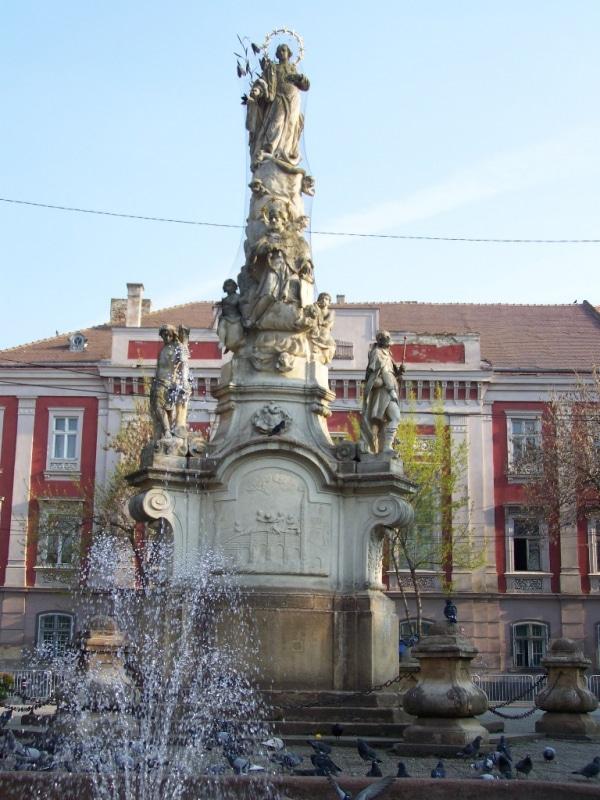
Removed from Unnamed collection
St. Mary and St. Nepomuk Monument 
The monument has two names – both used: “St. Mary monument” and “St. Nepomuk monument". Both are (and were) correct, but could cause confusion: there was another “Mary”, quite famous, and it is in the namesake square from Iosefin, and there is also another Nepomuk near the Millennium Church in Fabric. http://www.timisoara-info.ro/en/sightseeing/historical-quarters/cetate/tours/230-monumentul-sfintei-maria.html
Map

Removed from Unnamed collection
St. Mary Armenian Church 
The Armenian Church of Constanta is dedicated to "Saint Mary" and is situated on the seashore, near the Greek Church,on Callatis street. Less known by tourists, perhaps because the building stands out through a spectacular architecture, theArmenian Church embodies Armenian people living on Doborogea area is a important poin on the multiculturalism map of Constanta. https://www.litoralulromanesc.ro/en/biserica_armeneasca.htm
Map

Removed from Unnamed collection
St. Nicholas Church (1865) 
In the centre of the Tulcea, at the intersection of Frumoasa Street, Babadag Street and Progresului Street you can find Saint Nicolas Church, the Cathedral of Tulcea. Made of stone and brick, the building is 30 metres tall, in Byzantine style with three towers: two in front and the third (the largest one) is situated in the middle. http://www.tulcea.com/
Map

